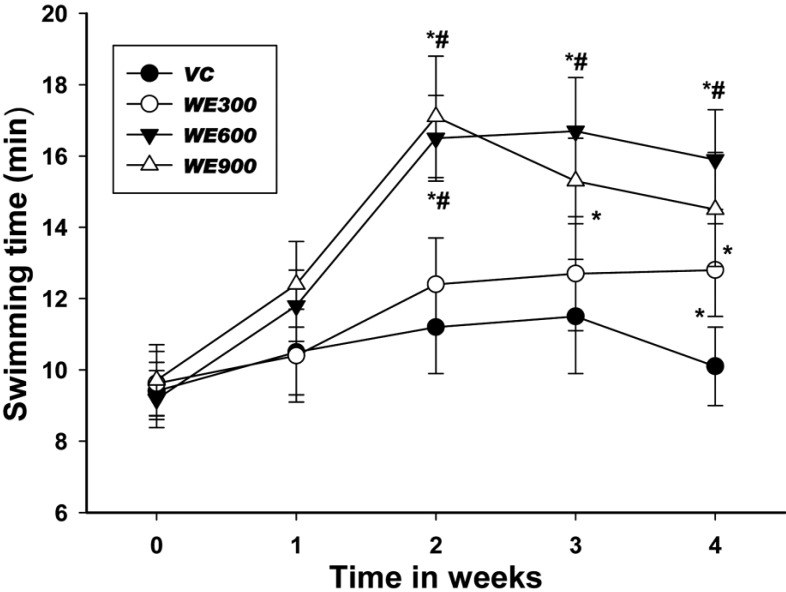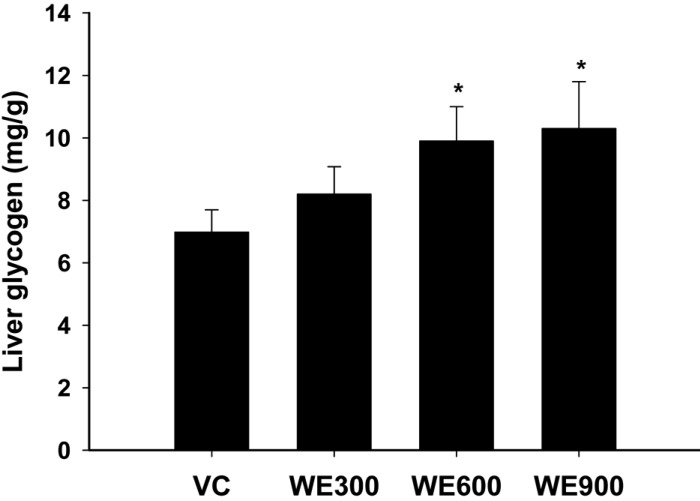Lab Anim Res.
2013 Dec;29(4):190-195. 10.5625/lar.2013.29.4.190.
Walnut extract exhibits anti-fatigue action via improvement of exercise tolerance in mice
- Affiliations
-
- 1Daegu Technopark Oriental Medicine Industry Support Center, Daegu, Korea.
- 2College of Veterinary Medicine, Kyungpook National University, Daegu, Korea. kskim728@knu.ac.kr
- KMID: 1716213
- DOI: http://doi.org/10.5625/lar.2013.29.4.190
Abstract
- This study was conducted to investigate the anti-fatigue effect of walnut extract (WE) on forced swimming capacity in mice. Twenty-eight male ICR mice were randomly divided into four groups, a vehicle control (VC) or one of three WE administered groups (300, 600 and 900 mg/kg/day). WE was orally administered to mice once a day for 4 weeks, during which time a forced swimming test was conducted once a week. The vehicle control group was given a corresponding volume of sterile distilled water. After 4 weeks, the forced swimming capacity and levels of blood lactate, glucose, glutamine, ammonia and triacylglycerol, and liver glycogen were measured. In the WE administration group (600 and 900 mg/kg) the maximum swimming time increased significantly when compared with the vehicle control group. WE (600 and 900 mg/kg) significantly decreased the levels of lactate andammonia and increased the blood glutamine levels and liver glycogen content after forced swimming relative to the vehicle control group. The results of this study demonstrated the anti-fatigue effects of WE in a dose-dependent manner. The effects of WE at 600 and 900 mg/kg were similar. Overall, these results suggest that walnut has anti-fatigue activity and could elevate exercise tolerance.
MeSH Terms
Figure
Reference
-
1. Gandevia SC. Spinal and supraspinal factors in human muscle fatigue. Physiol Rev. 2001; 81(4):1725–1789. PMID: 11581501.
Article3. Ream E, Richardson A. Fatigue: a concept analysis. Int J Nurs Stud. 1996; 33(5):519–529. PMID: 8886902.
Article4. Tharakan B, Dhanasekaran M, Manyam BV. Antioxidant and DNA protecting properties of anti-fatigue herb Trichopus zeylanicus. Phytother Res. 2005; 19(8):669–673. PMID: 16177968.5. Murase T, Haramizu S, Shimotoyodome A, Tokimitsu I, Hase T. Green tea extract improves running endurance in mice by stimulating lipid utilization during exercise. Am J Physiol Regul Integr Comp Physiol. 2006; 290(6):R1550–R1556. PMID: 16410398.
Article6. Wang JJ, Shieh MJ, Kuo SL, Lee CL, Pan TM. Effect of red mold rice on antifatigue and exercise-related changes in lipid peroxidation in endurance exercise. Appl Microbiol Biotechnol. 2006; 70(2):247–253. PMID: 15983804.
Article7. Mague SD, Pliakas AM, Todtenkopf MS, Tomasiewicz HC, Zhang Y, Stevens WC Jr, Jones RM, Portoghese PS, Carlezon WA Jr. Antidepressant-like effects of kappa-opioid receptor antagonists in the forced swim test in rats. J Pharmacol Exp Ther. 2003; 305(1):323–330. PMID: 12649385.8. Deyama T, Nishibe S, Nakazawa Y. Constituents and pharmacological effects of Eucommia and Siberian ginseng. Acta Pharmacol Sin. 2001; 22(12):1057–1070. PMID: 11749801.9. Iwamoto M, Imaizumi K, Sato M, Hirooka Y, Sakai K, Takeshita A, Kono M. Serum lipid profiles in Japanese women and men during consumption of walnuts. Eur J Clin Nutr. 2002; 56(7):629–637. PMID: 12080402.
Article10. Feldman EB. The scientific evidence for a beneficial health relationship between walnuts and coronary heart disease. J Nutr. 2002; 132(5):1062S–1101S. PMID: 11983840.
Article11. Ros E, Núñez I, Pérez-Heras A, Serra M, Gilabert R, Casals E, Deulofeu R. A walnut diet improves endothelial function in hypercholesterolemic subjects: a randomized crossover trial. Circulation. 2004; 109(13):1609–1614. PMID: 15037535.12. Comba A, Maestri DM, Berra MA, Garcia CP, Das UN, Eynard AR, Pasqualini ME. Effect of ω-3 and ω-9 fatty acid rich oils on lipoxygenases and cyclooxygenases enzymes and on the growth of a mammary adenocarcinoma model. Lipids Health Dis. 2010; 9:112. PMID: 20932327.
Article13. Ma Y, Njike VY, Millet J, Dutta S, Doughty K, Treu JA, Katz DL. Effects of walnut consumption on endothelial function in type 2 diabetic subjects: a randomized controlled crossover trial. Diabetes Care. 2010; 33(2):227–232. PMID: 19880586.14. Li L, Tsao R, Yang R, Liu C, Zhu H, Young JC. Polyphenolic profiles and antioxidant activities of heartnut (Juglans ailanthifolia var. cordiformis) and Persian walnut (Juglans regia L.). J Agric Food Chem. 2006; 54(21):8033–8040. PMID: 17032006.15. Yoon MS. Effects of Walnut Extracts on cytokines in Mice Spleen with DNCB-induced Dermatitis. J Korean Soc Cosmetol. 2009; 15(3):1033–1040.16. Ikarashi N, Fukazawa Y, Toda T, Ishii M, Ochiai W, Usukura M, Sugiyama K. Effect of Conclevan on endurance capacity in mice. Biol Pharm Bull. 2012; 35(2):231–238. PMID: 22293354.
Article17. Fukuda T, Ito H, Yoshida T. Antioxidative polyphenols from walnuts (Juglans regia L.). Phytochemistry. 2003; 63(7):795–801. PMID: 12877921.18. Reiter RJ, Manchester LC, Tan DX. Melatonin in walnuts: influence on levels of melatonin and total antioxidant capacity of blood. Nutrition. 2005; 21(9):920–924. PMID: 15979282.
Article19. Banel DK, Hu FB. Effects of walnut consumption on blood lipids and other cardiovascular risk factors: a meta-analysis and systematic review. Am J Clin Nutr. 2009; 90(1):56–63. PMID: 19458020.
Article20. Rajaram S, Haddad EH, Mejia A, Sabaté J. Walnuts and fatty fish influence different serum lipid fractions in normal to mildly hyperlipidemic individuals: a randomized controlled study. Am J Clin Nutr. 2009; 89(5):1657S–1663S. PMID: 19339404.
Article21. Davis PA, Vasu VT, Gohil K, Kim H, Khan IH, Cross CE, Yokoyama W. A high-fat diet containing whole walnuts (Juglans regia) reduces tumour size and growth along with plasma insulinlike growth factor 1 in the transgenic adenocarcinoma of the mouse prostate model. Br J Nutr. 2012; 108(10):1764–1772. PMID: 22244053.22. Hill JO, Peters JC, Lin D, Yakubu F, Greene H, Swift L. Lipid accumulation and body fat distribution is influenced by type of dietary fat fed to rats. Int J Obes Relat Metab Disord. 1993; 17(4):223–226. PMID: 8387971.23. Kimura Y, Sumiyoshi M. Effects of various Eleutherococcus senticosus cortex on swimming time, natural killer activity and corticosterone level in forced swimming stressed mice. J Ethnopharmacol. 2004; 95(2-3):447–453. PMID: 15507373.
Article24. Cairns SP. Lactic acid and exercise performance: culprit or friend? Sports Med. 2006; 36(4):279–291. PMID: 16573355.25. Robergs RA, Ghiasvand F, Parker D. Biochemistry of exerciseinduced metabolic acidosis. Am J Physiol Regul Integr Comp Physiol. 2004; 287(3):R502–R516. PMID: 15308499.
Article26. Carvalho-Peixoto J, Alves RC, Cameron LC. Glutamine and carbohydrate supplements reduce ammonemia increase during endurance field exercise. Appl Physiol Nutr Metab. 2007; 32(6):1186–1190. PMID: 18059593.
Article
- Full Text Links
- Actions
-
Cited
- CITED
-
- Close
- Share
- Similar articles
-
- Fatigue and Exercise in Middle-aged Women
- Gynostemma pentaphyllum extract and its active component gypenoside L improve the exercise performance of treadmill-trained mice
- The Effect of L-Carnitine Supplementation on the Dystrophic Muscle and Exercise Tolerance of Muscular Dystrophy (mdx) Mice
- Effects of taurine and ginseng extracts on energy metabolism during exercise and their anti-fatigue properties in mice
- Inhibitory Effects of Corni Fructus Extract on Angiogenesis and Adipogenesis



